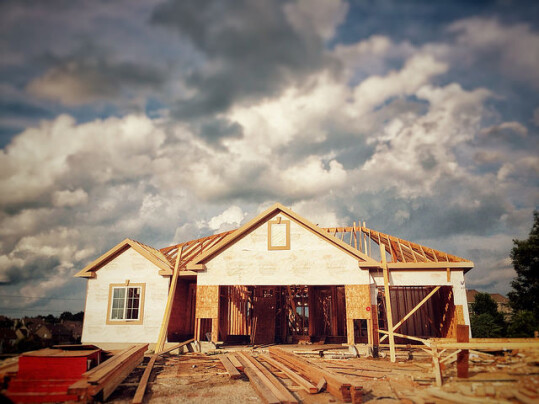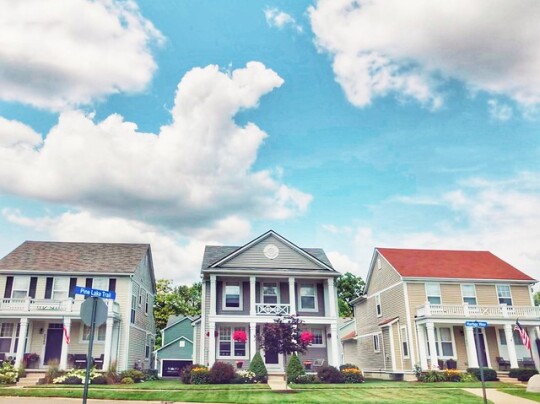Each month, the National Association of Home Builders conducts a survey to gauge builders’ perceptions of the current market for newly built single-family homes. Their monthly measure of home builder confidence is a closely watched housing market indicator, as home builders have a unique perspective on the market. In November, builder confidence fell from the month before. Jerry Konter, NAHB’s chairman, says higher mortgage rates have slowed demand. “Higher interest rates have significantly weakened demand for new homes as buyer traffic is becoming increasingly scarce,” Konter said. But slower demand may hold benefits for buyers still active in the market. According to the survey, more builders say they’re now offering incentives in an effort to bring in buyers. In fact, among participants, 59 percent said they’re using incentives – including paying points and mortgage-rate buy downs. An increasing number of builders also report lowering prices in November, with an average price reduction of 6 percent. (source)
Archive for November 2022
Slower New Home Market May Benefit Buyers
Mortgage Rates See Biggest Drop Since July
According to the Mortgage Bankers Association’s Weekly Applications Survey, average mortgage rates for 30-year fixed-rate mortgages with conforming loan balances saw their biggest week-over-week decline in months last week. Rates for 15-year fixed-rate loans and 5/1 ARMs also fell, while rates for jumbo and FHA loans were relatively flat from the week before. Joel Kan, MBA’s vice president and deputy chief economist, says the decline was the result of inflation slowing. “Mortgage rates decreased last week as signs of slower inflation pushed Treasury yields lower,” Kan said. “The 30-year fixed rate saw the largest single-week decline since July 2022.” Declining rates helped spur a 4 percent increase in the number of prospective home buyers applying for loans to buy homes. Refinance activity, however, was down from the week before and remains significantly lower than last year at the same time. The MBA’s weekly survey has been conducted since 1990 and covers 75 percent of all retail residential mortgage applications. (source)
Credit Availability Unchanged In October
The standards lenders use to determine whether or not a borrower is approved for a mortgage aren’t fixed. Depending on market conditions, getting a mortgage may be easier at one point and more difficult the next. Because of this, the Mortgage Bankers Association keeps a monthly measure of mortgage credit availability. The index was benchmarked to 100 in March 2012 and any increase is indicative of looser credit while a decline is evidence that standards are tightening. In October, the MBA found mortgage credit availability relatively flat from the month before, with the overall index falling just 0.5 percent one month earlier. The biggest declines were seen for jumbo loans, which experienced a 2.5 percent drop month-over-month. Joel Kan, MBA’s vice president and deputy chief economist, says higher rates and an uncertain economy have led to some tightening. “Mortgage credit availability declined for the eight straight month in October to its lowest level since March 2013,” Kan said. “Much higher mortgage rates and the worsening outlook for the housing market and economy are behind the continued tightening in credit availability.” (source)
How Affordable Is Today’s Housing Market?
It’s no secret that the housing market has been more challenging this year. Higher mortgage rates, combined with still-high home prices, low inventory, and an uncertain economy, have had an effect on affordability conditions. It may have you wondering whether or not it’s a good time to buy. After all, how many homes out there are actually affordable to the typical buyer? Well, according to the National Association of Home Builders’ Housing Opportunity Index – which tracks how affordable new and existing homes are to families earning the median income of $90,000 – 42.2 percent of the homes sold between the beginning of July and the end of September could be considered affordable. That’s down from last year at this time when it was closer to 55 percent. It’s also the lowest it’s been since after the Great Recession, when nearly 80 percent of homes were considered affordable. Still, the typical buyer could expect to comfortably afford just under half of all the homes available for sale during the third quarter. And, depending on where you’re looking to buy, that number could be even higher. (source)
Number Of Available Homes For Sale Rises
The number of available homes for sale is up 42 percent from where it was last year at this time, according to new numbers from the National Association of Realtors’ consumer website. The analysis – which looked at the housing market through the week ending November 5 – found active inventory up for the fourth consecutive week. That’s good news for home buyers. It means more options, less competition, and more time to make buying decisions. In fact, the data shows homes for sale are spending an extra week on the market compared to the same time last year. But while a growing number of homes for sale is encouraging after years of historically low inventory, the improvement isn’t due to new listings – which are down from last year. That’s an indication that the inventory gains are more likely the result of fewer home buyers active in the market than a rush of new sellers listing their homes. (source)
Most Movers Prefer To Stay Closer To Home
The thought of moving to a far-off destination can be tempting. But while the fantasy of moving somewhere new is exciting, the reality is most of us prefer to stay closer to home. There are many reasons for this, some of which are obvious like family, friends, and work. Having connections to a place – not to mention the expensive of a long-distance move – keeps the vast majority of American movers close to where they already call home. In fact, according to one recent analysis, 83 percent of recent movers looked to stay in the state where they lived. That’s a little bit lower than it was a few years ago, when it was close to 85 percent. Still, it’s pretty solid evidence that, though we may dream of packing up and hitting the road, most home buyers are looking for a house somewhere close to home. Among states, the two with the highest percentage of in-state movers were Michigan and Texas. The states with the highest percentage of movers who were looking to leave were New York and Hawaii. (source)
Demand For Home Purchase Loans Increases
According to the Mortgage Bankers Association’s Weekly Applications Survey, demand for loans to buy homes increased last week for the first time in more than a month. The improvement was slight and, when combined with a 4 percent drop in refinance activity, meant the MBA’s Market Composite Index – which measures overall mortgage demand – was virtually unchanged from the previous week. Joel Kan, MBA’s vice president and deputy chief economist, says demand remains low. “Purchase applications increased for the first time after six weeks of declines but remained close to 2015 lows, as home buyers remained sidelined by higher rates and ongoing economic uncertainty,” Kan said. “Refinances continued to fall, with the index hitting its lowest level since August 2000.” That demand has slowed isn’t surprising, especially since mortgage rates continue to climb. Last week, rates were up across most loan categories, including 30-year fixed-rate loans with conforming balances, loans backed by the Federal Housing Administration, 15-year fixed-rate loans, and 5/1 ARMs. The MBA’s weekly survey has been conducted since 1990 and covers 75 percent of all retail residential mortgage applications. (source)







